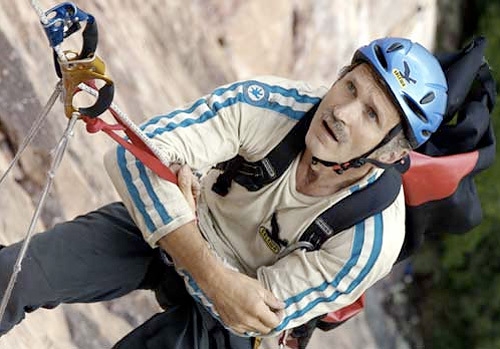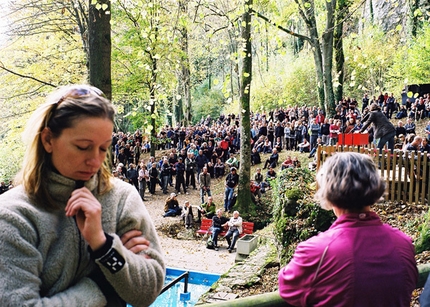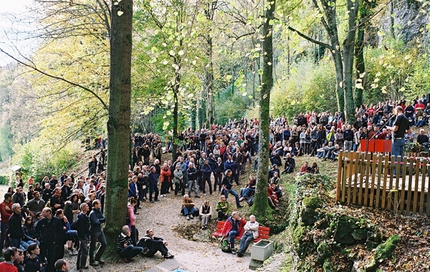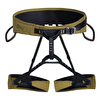Kurt Albert is dead. Goodbye to a climbing legend

 1 / 8
1 / 8 Klaus Fengler
Klaus Fengler
It's impossible to know where to start. Perhaps from the tragic end. Kurt Albert died yesterday evening in the Erlangen hospital in Bavaria, Germany. Kurt failed to recover from the serious injuries after falling from the Höhenglücksteig via ferrata on Sunday. Precise details of the accident are unknown, but these seem superfluous. What counts is that one of the world's most prolific and successful sport climbers and alpinists is no longer with us.
Albert's importance and influence of our sport cannot be underestimated. Born on 28 January 1954 in Nürnberg, he began climbing at 14 years of age in his local Frankenjura and soon progressed to classic alpine routes, such as the Walker Spur on the Grandes Jorasses and the North Face of the Eiger, as well routes in the Italian Dolomites which he held in the highest regard. While these alpine climbs laid the groundwork for Albert's future career, his young heart lay in exploring and pushing the physical limits of rock climbing which, at the time, lay in its embryonic stage and was stifled by old traditions which seemed in contrast with the new dreams and energies of the "young" free climbing movement.
After an early trip to the Elbsandstein in Saxony Albert realised that technical aid climbing was a dead-end street and that the future lay elsewhere. So, in 1975 he solved the conflict between the generations, between the aid and free climbers, by introducing the "rotpunkt" philosophy. By painting a red dot at the base of a route he indicated that a line had been climbed free, without the use of any aid whatsoever, which was left in place for those still wishing to climb existing routes in the original manner. The idea of free climbing spread like wildfire across the globe and along with "on-sight", Albert's term "redpoint" is nowadays considered to be the basis on which performances are measured in this sport.
Together with a handful of other young climbers including Wolfgang "Flipper" Fietz, Norbert Bätz, Norbert Sandner and a short while later his close friend Wolfgang Güllich, Albert immediately set about establishing harder and harder routes in his Frankenjura. In 1977 he carried out the first ascent of "Osterweg" (VIII-), while his "Sautanz" (IX-, 1981) and above all "Magnet" (IX,1982) are considered true milestones in German sport climbing. Albert became a leading figure in his country, so much so that in 1984 he, Wolfgang Güllich and Sepp Gschwendtner were awarded the "Silberne Lorbeerblatt" - the highest sport accolade - by the German government for their services to climbing.
But Albert's interest in the vertical sphere was by no means limited to the innumerable crags dotted throughout the Frankenjura and along with some of Germany's finest climbers he soon turned his attention to exporting the repoint ideal to the biggest walls in the world.
In 1987 he travelled to the massive Tre Cime di Lavaredo in the Dolomites where, together with Gerold Sprachmann, he carried out the first free ascent of the Swiss route on Cima Ovest as well as he first free ascent of the world famous Hasse - Brandler on Cima Grande. In 1988 he travelled to the Karakorum with Wolfgang Güllich and Hartmut Münchenbach and carried out the first free ascent of the Yugoslav route (Slavko Cankar, Francek Knez, Bojan Srot, 1987) up the 6242m high Nameless Tower on Trango Tower. In many respects this expedition was a mere "warm-up" to one of Albert's most prestigious creations, the nearby "Eternal Flame", climbed in the summer of 1989 along with Wolfgang Güllich, Christof Stiegler and Milan Sykora. The four forged a new line up the Nameless Tower spied the previous year and the ascent proved an enticing mix of raw courage and blind determination, especially towards the end when Stiegler and Sykora had to return home. With Güllich injured, Albert pulled out all the stops to reach the summit, resulting in free climbing up to 7b+ and four sections of aid. "Eternal Flame" paved the way for a new dimension of sport climbing in the Himalaya, touching on difficulties hitherto unthought of.
Not only the Himalaya. The Albert - Güllich climbing partnership proved so successful (the two lived together for 11 years) that a year later the duo teamed up with Norbert Bätz, Peter Dittrich and Bernd Arnold to establish the beautiful "Riders on the Storm", a direct 1300m line up the compact granite East Face of Paine's Central Tower. Patagonia impressed Albert deeply and in 1995 he returned with Bernd Arnold once again, and with Jorg Gerschel and Lutz Richter he established the 44 pitch, 7c/A2 "Royal Flush" on the East Pillar of Fitz Roy. Of all his big walls, Albert always considered this as his most important.
Although always extremely at ease at home in front of a big mug of coffee in the company of close friends such as Jerry Moffatt, the former teacher of physics and mathematics constantly sought new challenges. This is how the idea of confronting the mountains "by fair means" came about, which translated into approaching some of the world's remotest peaks without the use of porters or motorised assistance. At the start of the new millennium he experimented this concept together with Stefan Glowacz, Holger Hember and Gerd Heidorn by climbing the 500m "Odyssey 2000" on Baffin Island's granite Polar Bear Spire. More than just a route, the line was the culmination of an epic adventure which the four climbers completed in complete autonomy, transporting all the gear for over 400km in one of the most inhospitable parts of the planet.
Albert embraced this new philosophy with open arms and this immediately became his Leitmotif in the years that followed, often in the compnay of Stefan Glowacz. Almost no season went by without a significant first ascent of some remote big wall across the globe and by "fair means" has become synonymous with a purest form of climbing possible and adopted by some of the world's finest climbers.
Kurt Albert first experimented this pure form of climbing as a gifted youngster in the late 60's at his local crags, in the Frankenjura. 50 years later, he has left his lasting impression on some of the finest mountains in the world.
Kurt Albert -significant ascents and dates
1954 Born in Nürnberg, Germany on 28/01
1968 Started climbing in home Frankenjura
1973 Trip to the Elbsandstein. Opened eyes to potential of free climbing
1975 Development of the Rotpunkt philosophy. The Adolf-Rott-Ged. Weg (VI+) in the Frankenjura was the first route to be marked with a red dot
1977 FA Devil's Crack (VII) & Osterweg (VIII-), Frankenjura
1979 Solo Devil's Crack (VII), Röthelfels, Frankenjura
1980 FA Rubberneck (VIII+), Richard Wagnser Fels, Frankenjura
1981 FA Sautanz (IX-), Frankenjura
1982 FA Magnet (IX-), the hardest route in the Frankenjura
1986 Solo Fight Gravity (VIII+), Richard Wagner Fels, Frankenjura
1987 FFA Hasse - Brandler (VIII) on Cima Grande, Dolomites
1987 FFA Swiss Route (IX-) on Cima Ovest, Dolomites
1987 Solo Rubberneck (VIII+), Richard Wagnser Fels, Frankenjura
1988 Solo Courage Fouyons (7b), Buoux, France
1988 FFA Yugoslav route (7a+), Nameless Tower, Karakorum
1989 FA Eternal Flame (IX-, 3 points of aid), Nameless Tower, Karakorum
1990 FA Riders on the Storm (IX), Paine Central Tower, Patagonia
1993 FA Stairway to Heaven (IX), Roraima, Venezuela
1994 FA Moby Dick (IX+), Ulamertorsuaq, Greenland
1995 FA Royal Flush (IX), Fitz Roy, Patagonia
1995 FA Fitzcarraldo (VIII+) Mount Harrison Smith, Cirque of Unclimbables, Canada
1996 FA Gelbe Mauer (IX) Tre Cime di Lavaredo
1997 FA Nordlicht (VIII+), Tupilak, Greenland
1998 FA El Condorito (IX), Aguja St. Exupery, Patagonia
1999 FA Vela y Viento (IX-), Aguja Mermoz, Patagonia
1999 FA Hart am Wind (VIII+), Cape Renard Tower, Antarctica
2000 Repeat of Franco Argentine route, Fitz Roy, Patagonia
2000 FA Odyssee 2000 (VIII+, 500m), Baffin Island, Canada
2002 FA on Vampire Peak (VIII+), Lotus Mountain, Canada
2003 Repeat Story About Dancing Dogs (IX/600m) Mt. Poi, Ndoto Mountains, Kenya
2006 FA El Purgatorio (650m/IX), Acopan Tepuis, Venzuela
2007 Expedition to Sablija, Ural, Russia
2008 FA El Nido del TirikTirik (7b/400m) Castillo, Venezuela
2009 FA Hotel Guácharo (7a+/550m) Roraima-Tepuis, Venezuela
FA = First ascent
FFA = First free ascent
| Links www | |
| www.climbing.de | |
| www.kurt-albert.de | |



 Copia link
Copia link







 See all photos
See all photos























